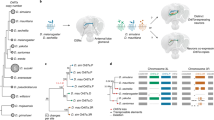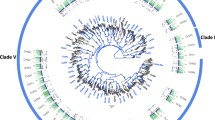Abstract
The evolution and patterns of selection of genes encoding 10 Drosophila odorant receptors (Or) and the sex pheromone receptor Gr68a were investigated by comparing orthologous sequences across five to eight ecologically diverse species of Drosophila. Using maximum likelihood estimates of dN/dS ratios we show that all 11 genes sampled are under purifying selection, indicating functional constraint. Four of these genes (Or33c, Or42a, Or85e, and Gr68a) may be under positive selection, and if so, there is good evidence that 12 specific amino acid sites may be under positive selection. All of these sites are predicted to be located either in loop regions or just inside membrane spanning regions, and interestingly one of the two sites in Gr68a is in a similar position to a previously described polymorphism in Gr5a that causes a shift in sensitivity to its ligand trehalose. For three Ors, possible evidence for positive selection was detected along a lineage. These include Or22a in the lineage leading to D. mauritiana and Or22b in the lineage leading to D. simulans. This is of interest in light of previous data showing a change in ligand response profile for these species in the sensory neuron (ab3A) which expresses both Or22a and Or22b in D. melanogaster. In summary, while the main chemosensory function and/or structural integrity of these 10 Or genes and Gr68a are evolutionarily preserved, positive selection appears to be acting on some of these genes, at specific sites and along certain lineages, and provides testable hypotheses for further functional experimentation.



Similar content being viewed by others
References
Altschul SF, Gish W, Miller W, Myers EW, Lipman DJ (1990) Basic local alignment search tool. J Mol Biol 215:403–410
Benton R, Sachse S, Vosshall LB (2006) Atypical membrane topology and heteromeric function of Drosophila odorant receptors in vivo. PLoS Biol 4:1–18
Branscomb A, Seger J, White RL (2000) Evolution of odorant receptors expressed in mammalian testes. Genetics 156:785–797
Bray S, Amrein H (2003) A putative Drosophila pheromone receptor expressed in male-specific taste neurons is required for efficient courtship. Neuron 39:1019–1029
Clyne PJ, Warr CG, Freeman MR, Lessing D, Kim J, Carlson JR (1999) A novel family of divergent seven-transmembrane proteins: candidate odorant receptors in Drosophila. Neuron 22:327–338
de Bruyne M, Warr CG (2006) Molecular and cellular organization of insect chemosensory neurons. BioEssays 28:23–34
de Bruyne M, Clyne PJ, Carlson JR (1999) Odor coding in a model olfactory organ: the Drosophila maxillary palp. J Neurosci 19:4520–4532
de Bruyne M, Foster K, Carlson JR (2001) Odor coding in the Drosophila antenna. Neuron 30:537–552
Dekker T, Ibba I, Siju KP, Stensmyr MC, Hansson BS (2006) Olfactory shifts parallel superspecialism for toxic fruit in Drosophila melanogaster sibling, D. sechellia. Curr Biol 16:101–109
Dobritsa AA, van der Goes Naters W, Warr CG, Steinbrecht RA, Carlson JR (2003) Integrating the molecular and cellular basis of odor coding in the Drosophila antenna. Neuron 37:827–841
Fischer A, Gilad Y, Man O, Paabo S (2004) Evolution of bitter taste receptors in humans and apes. Mol Biol Evol 22:432–436
Gao Q, Chess A (1999) Identification of candidate Drosophila olfactory receptors from genomic DNA sequence. Genomics 60:31–39
Goldman AL, van der Goes Naters W, Lessing D, Warr CG, Carlson JR (2005) Coexpression of two functional odor receptors in one neuron. Neuron 45:661–666
Hallem EA, Dahanukar A, Carlson JR (2006) Insect odor and taste receptors. Annu Rev Entomol 51:113–35
Higa I, Fuyama Y (1993) Genetics of food preference in Drosophila sechellia. Genetica 88:129–136
Higgie M, Chenoworth S, Blows MW (2000) Natural selection and the reinforcement of mate recognition. Science 290:519–520
Howard RW, Jackson LL, Banse H, Blows MW (2003) Cuticular hydrocarbons of Drosophila birchii, D. serrata: Identification and role in mate choice in D. serrata. J Chem Ecol 29:961–976
Hughes AL, Ota T, Nei M (1990) Positive darwinian selection promotes charge profile diversity in the antigen-binding cleft of class i major-histocompatibility-complex molecules. Mol Biol Evol 7:515–524
Kreher SA, Kwon JY, Carlson JR (2005) The molecular basis of odor coding in the Drosophila larva. Neuron 46:445–456
Mundy NI, Cook S (2003) Positive selection during the diversification of class i vomeronasal receptor-like (V1RL) genes, putative pheromone receptor genes, in human and primate evolution. Mol Biol Evol 20:1805–1810
Nielsen R, Yang Z (1998) Likelihood models for detecting positively selected amino acid sites and applications to the HIV-1 envelope gene. Genetics 148:929–936
Otaki JM, Yamamoto H (2003) Length analyses of Drosophila odorant receptors. J Theor Biol 223:27–37
Powell JR (1997) Progress and prospects in evolutionary biology. The Drosophila model. Oxford University Press, New York
Probst WC, Snyder LA, Schuster DI, Brosius J, Sealfon SC (1992) Sequence alignment of the G-protein coupled receptor superfamily. DNA Cell Biol 11:1–20
Richards S, Liu Y, Bettencourt BR, Hradecky P, Letovsky S, Nielsen R, Thornton K, Hubisz MJ, Chen R, Meisel RP, Couronne O, Hua S, Smith MA, Zhang P, Liu J, Bussemaker HJ, van Batenburg MF, Howells SL, Scherer SE, Sodergren E, Matthews BB, Crosby MA, Schroeder AJ, Ortiz-Barrientos D, Rives CM, Metzker ML, Muzny DM, Scott G, Steffen D, Wheeler DA, Worley KC, Havlak P, Durbin KJ, Egan A, Gill R, Hume J, Morgan MB, Miner G, Hamilton C, Huang Y, Waldron L, Verduzco D, Clerc-Blankenburg KP, Dubchak I, Noor MAF, Anderson W, White KP, Clark AG, Schaeffer SW, Gelbart W, Weinstock GM, Gibbs RA (2005) Comparative genome sequencing of Drosophila pseudoobscura: Chromosomal, gene and cis-element evolution. Genome Res 15:1–18
Robertson HM, Warr CG, Carlson JR (2003) Molecular evolution of the insect chemoreceptor gene superfamily in Drosophila melanogaster. Proc Natl Acad Sci USA 100:14537–14542
Russo CAM, Takezaki N, Nei M (1995) Molecular phylogeny and divergence times of Drosophilid species. Mol Biol Evol 12:391–404
Schiffer M, Carew ME, Hoffmann AA (2004) Molecular, morphological and behavioural data reveal the presence of a cryptic species in the widely studied Drosophila serrata species complex. J Evol Biol 17:430–442
Stensmyr MC, Dekker T, Hansson BS (2003) Evolution of the olfactory code in the Drosophila melanogaster subgroup. Proc R Soc London 270:2333–2340
Suzuki Y, Gojobori T (1999) A method for detecting positive selection at single amino acid sites. Mol Biol Evol 16:1315–1328
Suzuki Y, Nei M (2001) Reliabilities of parsimony-based and likelihood-based methods for detecting positive selection at single amino acid sites. Mol Biol Evol 18:2179–2185
Suzuki Y, Nei M (2002) Simulation study of the reliability and robustness of the statistical methods for detecting positive selection at single amino acid sites. Mol Biol Evol 19:1865–1869
Swanson WJ, Nielson R, Yang Q (2003) Pervasive adaptive evolution in mammalian fertilization proteins. Mol Biol Evol 20:18–20
Swofford D (1998) PAUP*. Phylogenetic Analysis Using Parsimony (*and other methods). Version 4. Sinnauer Associates, Sunderland, MA
Thomas JH, Kelley JL, Robertson HM, Ly K, Swanson WJ (2005) Adaptive evolution in the SRZ chemoreceptor families of Caenorhabditis elegans and Caenorhabditis briggsae. Proc Natl Acad Sci USA 102:4476–4481
Thompson JD, Higgins DG, Gibson TJ (1994) CLUSTALW: improving the sensitivity of progressive multiple sequence alignment through sequence weighting, position-specific gap penalties and weight matrix choice. Nucleic Acids Res 22:4673–4680
Ueno K, Ohta M, Morita H, Mikuni Y, Nakajima S, Yamamoto D, Isono K (2001) Trehalose sensitivity in Drosophila correlates with mutations in and expression of the gustatory receptor gene Gr5a. Curr Biol 11:1451–1455
Vosshall LB, Amrein H, Morozov PS, Rzhetsky A, Axel R (1999) A spatial map of olfactory receptor expression in the Drosophila antenna. Cell 96:725–736
Wong WSW, Yang Z, Goldman N, Nielsen R (2004) Accuracy and power of statistical methods for detecting adaptive evolution in protein coding sequences and for identifying positively selected sites. Genetics 168:1041–1051
Yang Z (1997) PAML: a program package for phylogenetic analysis by maximum likelihood. CABIOS 13:555–556
Yang Z (1998) Likelihood ratio tests for detecting positive selection and application to primate lysozyme evolution. Mol Biol Evol 15:568–573
Yang Z, Nielsen R (2000) Estimating synonymous and nonsynonymous substitution rates under realistic evolutionary models. Mol Biol Evol 17:32–43
Yang Z, Nielsen R (2002) Codon-substitution models for detecting molecular adaptation at individual sites along specific lineages. Mol Biol Evol 19:908–917
Yang Z, Nielsen R, Goldman N, Krabbe Pedersen A-M (2000) Codon-substitution models for heterogeneous selection pressure at amino acid sites. Genetics 155:431–449
Yang Z, Wong WSW, Nielsen R (2005) Bayes empirical Bayes inference of amino acid sites under positive selection. Mol Biol Evol 22:1107–1118
Acknowledgments
The authors would like to thank Dr. M. deBruyne for helpful comments on the manuscript and four anonymous reviewers for constructive suggestions regarding improving the manuscript and the evolutionary analysis. We would also like to thank Dr. Hugh Robertson for sharing unpublished information on the D. pseudoobscura Or genes gathered from the public genome database. This work was supported by grants from the Australian Research Council to C.G.W. and the Marsden Fund (02-HRT-016) to R.D.N.
Author information
Authors and Affiliations
Corresponding author
Additional information
[Reviewing Editor: Dr. David Pollock]
Electronic Supplementary Material
Rights and permissions
About this article
Cite this article
Tunstall, N.E., Sirey, T., Newcomb, R.D. et al. Selective Pressures on Drosophila Chemosensory Receptor Genes. J Mol Evol 64, 628–636 (2007). https://doi.org/10.1007/s00239-006-0151-6
Received:
Accepted:
Published:
Issue Date:
DOI: https://doi.org/10.1007/s00239-006-0151-6




